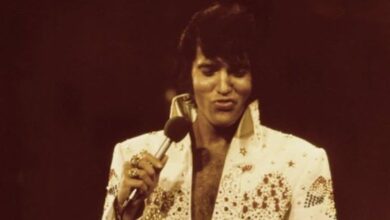John Anderson’s ‘Seminole Wind’ (1992): A Stirring Anthem That Brought Country Music Back to Its Roots
By the early 1990s, country music was in the midst of a seismic shift. The genre was embracing polished, radio-friendly sounds that leaned into pop influences, while traditionalists worried about the erosion of its roots. In this landscape, John Anderson’s Seminole Wind emerged as a poignant and powerful reminder of the genre’s storytelling strength. Released in 1992 as the title track of his comeback album, the song was a deeply personal, evocative ballad that spoke to environmental destruction, historical loss, and the enduring spirit of the Seminole people. It became one of Anderson’s defining hits, reaching No. 2 on the Billboard Hot Country Songs chart and proving that country music could still carry weighty themes while achieving commercial success.
Anderson had already established himself as a singular voice in country music by the early 1980s. With his unmistakable twang and blend of honky-tonk and outlaw country influences, he had enjoyed hits like Swingin’ and Wild and Blue. However, by the late ‘80s, his career had stalled. The new wave of country artists was taking over, and Anderson found himself struggling for relevance. Determined to make a comeback, he signed with BNA Records and began working on an album that would showcase his rich, soulful voice in a way that felt both contemporary and rooted in tradition. Seminole Wind became the anchor of this revitalization.
The inspiration for Seminole Wind came from Anderson’s deep connection to his home state of Florida. He had long been fascinated by the plight of the Seminole people and the ongoing destruction of Florida’s natural landscapes, particularly the Everglades. The song, which he wrote himself, was a lament for the vanishing beauty of his homeland, with its haunting refrain calling out to the “ghosts of the old Seminole” as the winds howled through the trees. This blend of environmental awareness and historical reflection was rare in mainstream country music, making the track stand out as both deeply personal and widely resonant.
Recording Seminole Wind required a production style that could match the weight of its lyrics. Produced by James Stroud, the track was built on a foundation of rich instrumentation, featuring a swelling fiddle, dobro, and pedal steel guitar that underscored Anderson’s soulful vocal delivery. The arrangement was lush but never overproduced, maintaining the raw emotion of Anderson’s performance while enhancing the song’s sweeping, cinematic quality. The combination of traditional country elements with a slightly more modern production aesthetic helped it bridge generational gaps within the genre.
When Seminole Wind was released as a single, it quickly became one of Anderson’s biggest hits in over a decade. It peaked at No. 2 on the country charts and gained widespread airplay, proving that audiences were still hungry for meaningful, well-crafted country songs. The album itself was a massive success, eventually going double platinum—a rarity for an artist making a comeback. The song also resonated outside of traditional country circles, drawing in listeners who were moved by its environmental message and haunting melody.
Beyond its chart success, Seminole Wind had a lasting cultural and industry impact. At a time when country music was increasingly shifting toward polished, pop-oriented sounds, Anderson’s hit served as a reminder of the power of authenticity. The song’s themes of conservation and history were groundbreaking in the genre, predating the more socially conscious country songs that would become more common in later decades. Additionally, it reinforced the idea that country music could be about more than just personal heartbreak or good times—it could tell bigger, more universal stories.
For Anderson himself, Seminole Wind was a career-defining moment. It reestablished him as a major force in country music and opened the door for further success in the ‘90s. The album’s success led to a resurgence in demand for Anderson as a touring artist, and he found himself playing to larger audiences than he had in years. It also helped him gain newfound respect as a songwriter, proving that he was more than just a great performer—he was a storyteller with something important to say.
The song’s influence extended beyond Anderson’s own career. It inspired a wave of country artists to embrace more socially aware themes in their music, paving the way for later hits that tackled issues like rural decline, environmentalism, and cultural heritage. Artists like Alan Jackson, who would later write Where Were You (When the World Stopped Turning), and Kenny Chesney, who often sings about the changing landscapes of the South, owe some creative debt to the trail Anderson blazed with Seminole Wind.
Over the years, Seminole Wind has been covered by several artists, each bringing their own interpretation to the song. The Charlie Daniels Band, known for their own blend of country and Southern rock, performed a rousing rendition that emphasized the song’s haunting, anthemic qualities. Additionally, bluegrass and folk musicians have taken on the track, proving that its themes and melodies are versatile enough to transcend strict genre boundaries.
While Seminole Wind marked Anderson’s resurgence, it also coincided with a broader moment of cultural reckoning in country music. The early ‘90s saw a return to traditionalism in many ways, with artists like Garth Brooks and Clint Black proving that country could be both commercially viable and deeply rooted in its heritage. Anderson’s hit was a crucial part of this movement, standing as a bridge between the genre’s past and future.
Even decades after its release, Seminole Wind remains one of Anderson’s most beloved songs. It continues to receive significant radio play, is a staple of his live performances, and is often cited as one of the best country songs of the ‘90s. It also continues to resonate as an environmental anthem, particularly in Florida, where efforts to protect the Everglades remain an ongoing concern. The song’s ability to blend personal nostalgia with a broader message has ensured its place in country music history.
Looking at the bigger picture, Seminole Wind played a crucial role in shaping how country music approached storytelling in the years that followed. Its willingness to tackle complex themes while still maintaining a strong emotional core set a precedent for later country songwriters who sought to go beyond simple narratives. It also proved that comeback stories were possible in Nashville—if an artist had the right song, they could reclaim their place in the industry.
John Anderson has since received numerous accolades for his contributions to country music, and Seminole Wind remains a centerpiece of his legacy. The song has been included in countless “best of” lists, cementing its place as a classic of the genre. Anderson himself has reflected on the track’s impact, often citing it as the song that means the most to him personally.
In the end, Seminole Wind stands as more than just a hit single—it’s a testament to the enduring power of storytelling in country music. It encapsulates themes of history, loss, and resilience, making it as relevant today as it was in 1992. For both John Anderson and the genre as a whole, it remains a defining moment—proof that sometimes, a song can be both deeply personal and universally resonant, shaping the landscape of country music in ways that few could have predicted.



